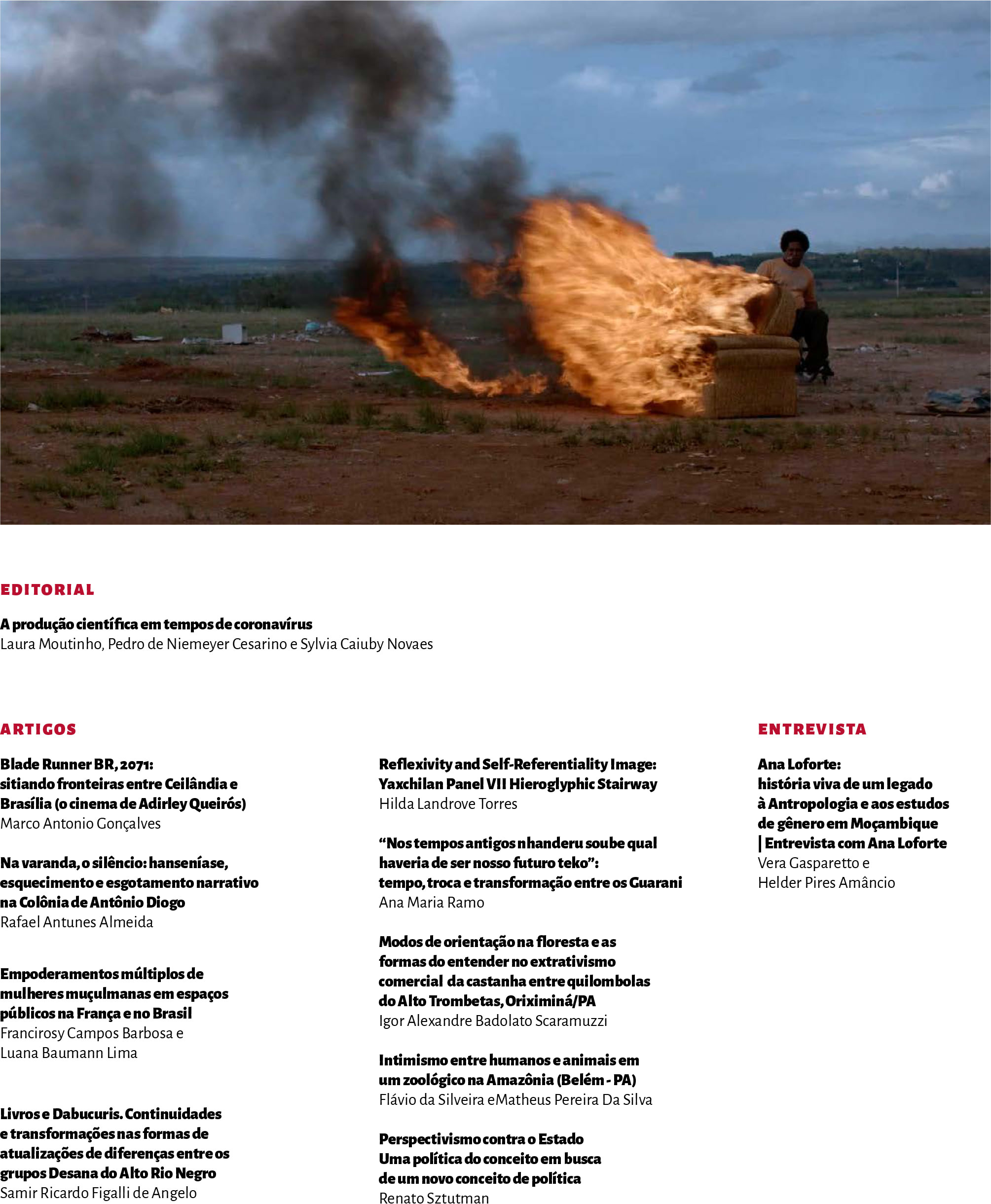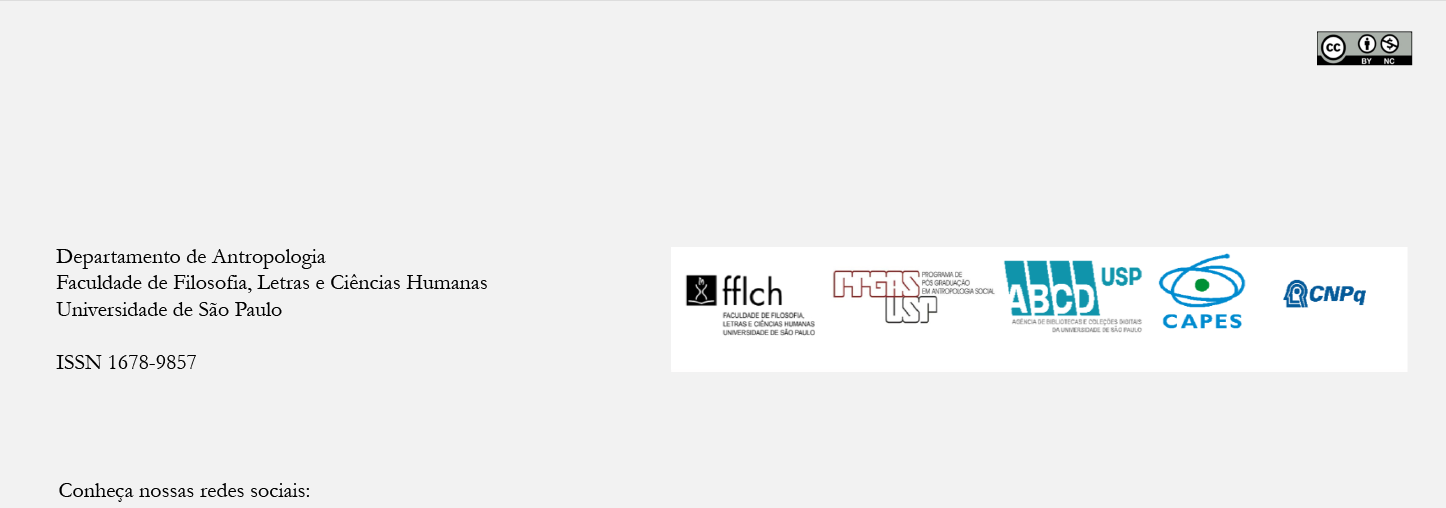Reflexivity and Self-Referentiality in Image. An Analysis of Yaxchilan Panel VII Hieroglyphic Stairway
DOI:
https://doi.org/10.11606/2179-0892.ra.2020.169169Keywords:
Self-referentiality, Reflexivity, Image, Anthropology of Art, MayaAbstract
This paper presents an analysis of ‘image-within-image’ in Panel VII, Hieroglyphic Stairway 2, Structure 33 of the ancient Maya city of Yaxchilan, considering the position it occupies in the set of panels and its integration in the architectural setting. It will also examine the narrative registered in the embedded text and the subject of both text and image. It will argue that the recursive device of ‘image-within-image’ in the Panel extends to the totality of the staircase with the other twelve that compose it, and to the ritual activity celebrated on it. The analysis will provide an opportunity to explore reflexivity and self-referentiality and their implications for insights on ritual and personhood among Late Classic Maya. To do this, I will build on anthropology of art approach and its notion that visual devices may elicit ontological conceptions.
Downloads
References
BOKODY, Peter. 2015. Images-within-Images in Italian Painting (1278-1348). Reality and Reflexivity. Ashgate Publishing, Ltd.
BRITTENHAM, Claudia. 2019. “Architecture, Vision, and Ritual: Seeing Maya Lintels at Yaxchilan Structure 23”, The Art Bulletin,101(3), 8-36.
CHASTEL, André. 1978. Fables, formes, figures 2. Paris, Flamarion.
COHODAS, Marvin. 1975. “The symbolism and ritual function of the Middle Classic ball game in Mesoamerica”, American Indian Quarterly, 99-130.
COHODAS, Marvin. 1991. “Ballgame imagery of the Maya Lowlands: history and iconography”, In SCARBOROUGH, Vernon and David R. WILCOX (eds.), The Mesoamerican Ballgame, University of Arizona Press, pp. 251-288.
DÄLLENBACH, Lucien. [1977]1989. The mirror in the text. Chicago, University of Chicago Press.
DEHOUVE, DANIEL2016 “A Play on Dimensions: Miniaturization and Fractals in Mesoamerican Ritual”, Journal of Anthropological Research, 504, 529.
DE NIEMEYER CESARINO, Pedro. 2016. “Corporalidades heterotópicas”, Revista Brasileira de Psicanálise, 50,2, 157-175.
FRASSANI, Alessa. 2016. “Depicting Mesoamerican Spirit World”, Ancient Mesoamerica, 27, 441-459.
GELL, Alfred . 1998. Art and Agency. An Anthropological Theory. New York, Oxford University Press Inc.GIDE, A. [1926] 1973. The Counterfeiters. London, Penguin.
GILLESPIE, Susan. 1991. “Ballgames and boundaries”, In SCARBOROUGH, Vernon and David R. WILCOX (eds.), The Mesoamerican Ballgame, University of Arizona Press, pp. 317-345.
GILLESPIE, Susan. 2008. “Aspectos corporativos de la persona (personhood) y la encarnación (embodiment) entre los mayas del período Clásico”, Estudios de cultura maya, 31, 65-81.
GRAHAM, Ian. 1982. Corpus of Maya Hieroglyphic Inscriptions, Vol. 3, Part. 3. Yaxchilan. Peabody Museum for Archaeology and Ethnology. Cambridge, Massachusetts, Harvard University.
GRUBE, Nikolai. 2004. “Akan The God of Drinking, Disease and Death”, Acta Mesoamericana 14, Continuity and Change: Maya Religious Practices in Temporal Perspective, Verlag Anton Saurwein, 59-76.
GRUBE, Nikolai and Werner NAHM. 1994. “A census of Xibalba: A complete inventory of Way characters on Maya ceramics”, In KERR, Justin (comp.), The Maya Vase Book V. 4, Princeton Art Museum, pp. 686-715.
HENDON, Julia. 2012. “Objects as Persons”, In HARRISON-BUCK, Eleanor, (ed.), Power and identity in archaeological theory and practice: case studies from ancient Mesoamerica, University of Utah Press, pp. 82-89.
HOUSEMAN, Michael. 2005. “The Red and the Black, A Practical Experiment for Thinking about Ritual”, In Don HANDELMAN, D. and Galina LINDQUIST (eds.), Ritual in its own right. Exploring the Dynamics of Transformation, New York, Oxford, Berghahn Books, pp: 75-79.
HOUSEMAN, Michael and Carlo SEVERI.1998. Naven, Or, The Other Self: A Relational Approach to Ritual Action. Brill, Vol 79.
HOUSTON, Stephen. 2014. The life within: Classic Maya and the matter of permanence. Yale University Press.
HOUSTON, Stephen and David STUART. 1989. The way Glyph Evidence for “co-essences” among the Classic Maya. Center for Maya Research Vol. 30
HOUSTON, Stephen and David STUART. 1996. “Of gods, glyphs and kings: divinity and rulership among the Classic Maya”, Antiquity, 70(268), 289-312.
HOUSTON, Stephen and David STUART. 1998. “The Ancient Maya Self: Personhood and Portraiture in the Classic period”, RES: Anthropology and Aesthetics, 33(1), 73-101.
HOUSTON, Stephen, David STUART and K. TAUBE. 2006. The Memory of Bones. Body. Being, and Experience among the Classic Maya. Texas, University of Austin.
LAGROU, Els. 2011. “Le graphisme sur les corps amérindiens. Des chimères abstraites?”, Gradhiva, 13, Pièges à voir, Pièges à penser, 69-93.
LEVI-STRAUSS, Claude. 1963. Split Representation in the Art of Asia and America. Basic Books.
LEVI-STRAUSS, Claude. 1974. From Honey to Ashes. New York, Harper & Row.
LEVI-STRAUSS, Claude. 1978. The Origin of Table Manners. Mythologiques3. New York, Harper & Row.
LÓPEZ AUSTIN, Alfredo. 1983. “Nota sobre la fusión y la fisión de los dioses en el panteón mexica”, Anales de antropología, 20 (2), 75-87.
MAGNY, Claude-Edmonde. 1950. Histoire du roman Français depuis 1918. France, Éditions du Seuil.
MILLER, Mary Ellen and Stephen HOUSTON. 1987. “The Classic Maya ballgame and its architectural setting: a study of relations between text and image”, RES: Anthropology and Aesthetics, 14(1), 46-65.
NEURATH, Johannes. 2016. “El sacrificio de un cuchillo de sacrificio”, Revista de Antropología, 59(1), 73-107.
O’NEIL, Megan. 2014. Engaging Ancient Maya Sculpture at Piedras Negras, Guatemala. University of Oklahoma Press.
OREJEL, J. L., D. STUART, N. GRUBE, W. NAHM and G. E. STUART. 1990. “The” axe/comb” Glyph as Ch’ak”, Center for Maya Research, V. 31.
PASZTORY, Esther. 1998. Teotihuacan. An Experiment in Living. University of Oklahoma Press.
SCARBOROUGH, Vernon. L. 1991. “Courting the Southern Maya Lowlands: A Study in Pre-Hispanic Ballgame Architecture”, In SCARBOROUGH, Vernon and David R. WILCOX (eds.), The Mesoamerican Ballgame, University of Arizona Press, pp. 129-144.
SCHELE, Linda and D. FREIDEL. 1991. “The courts of creation: ball courts, ballgames, and portals to the Maya otherworld”, In SCARBOROUGH, Vernon and David R. WILCOX (eds.), The Mesoamerican Ballgame, University of Arizona Press, pp. 289-315.
SCHELE, Linda and Mary Ellen MILLER. 1986. The Blood of Kings. Dynasty and Ritual in Maya Art. New York, George Brazilier-Kimbell Art Museum.
SEVERI, Carlo. 2002. “Memory, reflexivity and belief. Reflections on the ritual use of language”, Social Anthropology, 10(1), 23-40.
STOICHITA, Victor. 1997. The Self-Aware Image. An Insight into Early Modern Meta-Painting. Cambridge University Press.
STUART, David. 1996. “Kings of stone: A consideration of stelae in ancient Maya ritual and representation”, RES: Anthropology and Aesthetics, 29(1), 148-171.
STUART, David. 1998. “The Fire Enters his House: Architecture and Ritual in Classic Maya Text”, In HOUSTON, S. (ed.), Function and Meaning in Classic Maya Architecture. Washington DC, Dumbarton Oaks, pp. 373-425.
STUART, David. 2010. Comentarios sobre las inscripciones del Templo XIX de Palenque. San Francisco, The Pre-Columbian Art Research Institute.
TATE, Carolyn. 1992. Yaxchilan: The design of a Maya ceremonial city. University of Texas Press.
TAUBE, Karl. 1992. “The Major Gods of Ancient Yucatan”, Studies in pre-Columbian Art and Archeology, 32, Washington, D. C., Dumbarton Oaks Research Library and Collection.
TAUBE, Karl. 1993. Aztec and Maya Myths.Great Britain, British Museum Press.
TAUSSIG, Michael. 1993. Mimesis and Alterity: A Particular History of the Senses. New York, Routlege.
TOKOVININE, Alexander. 2002. “Divine patrons of the Maya ballgame”. Mesoweb Articles: www.mesoweb.com/features/tokovinine/Ballgame.pdf
VELÁSQUEZ, Erik. 2007. “La máscara de “rayos x”: Historia de un artilugio iconográfico en el arte maya”, Anales de Instituto de Investigaciones Estéticas, 90, 7-36.
VELÁSQUEZ, Erik. 2011 “Las entidades y las fuerzas anímicas en la cosmovisión maya clásica”. In MARTINEZ DE VELASCO, A. y M. E. VEGA (coords.) Voces de Piedra. México, Ámbar Diseño S.C., pp. 235-252.
ZAMORA, Alonso. 2016. “Deciphering Ontologies. Divination and “Infinition” in Classic Maya Inscriptions. Revista Antropologia(Sao Paulo, Online) V. 59, 73-89.
ZENDER, Marc. 2004. “Glyphs for “Handspan” and “Strike” in Classic Maya Ballgame Texts”, The PARI Journal, 4(4), 1-9.
WAGNER, Elizabeth. 2001. “Mitos de la creación y cosmografía de los mayas”, In GRUBE, Nikolai (ed.), Mayas. Una civilización milenaria, Tandem Verlag GambH,281-287.
WAGNER, Roy. 2012. “Figure-Ground Reversal Among the Barok”, HAU 2(1), 535-542.
Whatling, S. (2009). Putting Mise-En-Abyme in Its (Medieval) Place. Medieval “Mise en Abyme”: The Object Depicted within Itself.
WIRTH, Jean. 1988. “La representation de l’image dans l’art du Haut Moyen Age”, Revue de l’art, 79, 9-21
Published
Issue
Section
License
Copyright (c) 2020 Revista de Antropologia

This work is licensed under a Creative Commons Attribution 4.0 International License.
Authors who intend to publish in this journal must agree with the following terms:
- a) Authors retain copyright and grant the journal the right of first publication. The work is simultaneously licensed under the Creative Commons Attribution License, which allows the work to be shared as long as the author and the initial publication in this journal are appropriately credited.
- b) Authors are authorized to sign additional contracts for non-exclusive distribution of the version of the work published in this journal (e.g., to publish it as a book chapter), as long as the author and the initial publication in this journal are appropriately credited.
- c) Authors are allowed and encouraged to publish and distribute their work online (e.g. on their personal webpage) after the editorial process, for this can generate productive changes as well as increase the impact and citation of the work. See The Effect of Open Access Publications.




